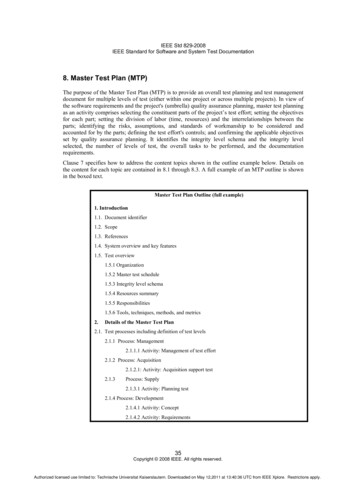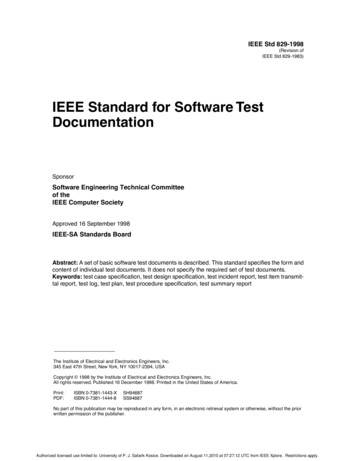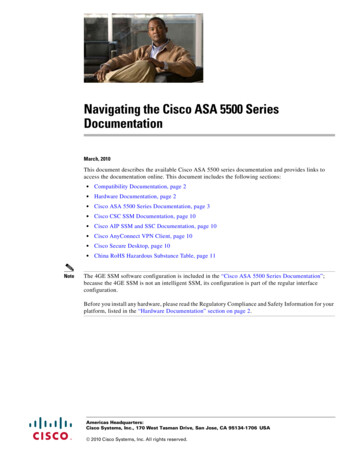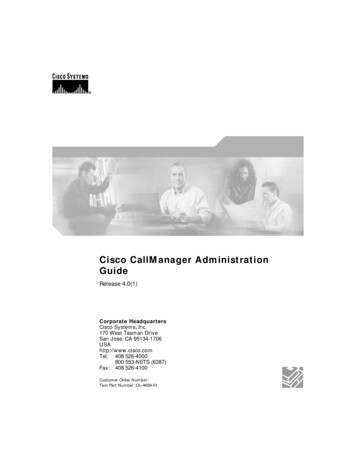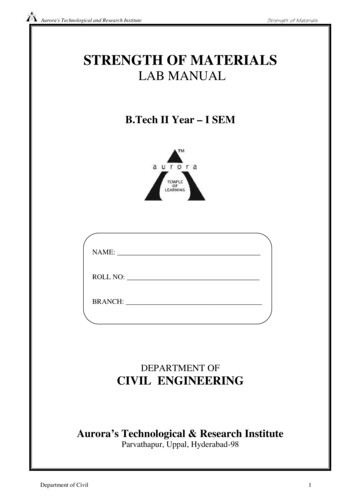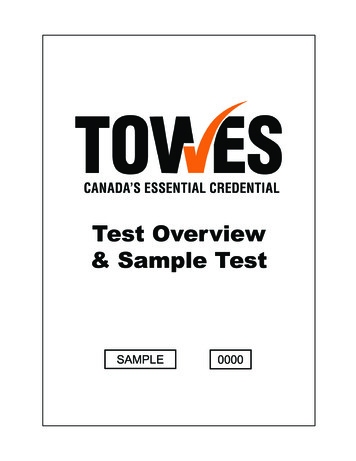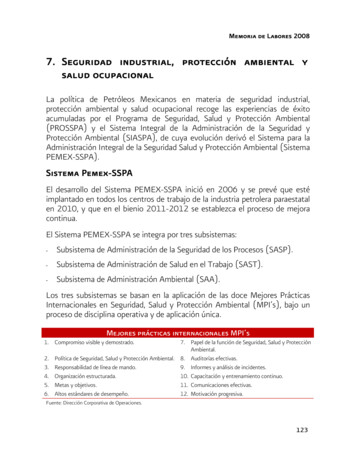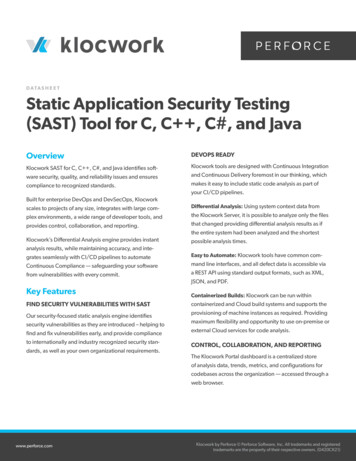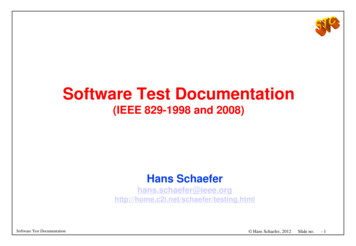
Transcription
Software Test Documentation(IEEE 829-1998 and 2008)Hans schaefer/testing.htmlSoftware Test Documentation Hans Schaefer, 2012Slide no.-1
Contents1 - To document or not to document2 - How much Documentation3 - IEEE Standard 829 - 1998 and 2008 and discussion4 - Key concepts in the new standard5 - Which Documents for WhatPart IIStandard 829-2008 templatesTest Policy and StrategySoftware Test Documentation Hans Schaefer, 2012Slide no.-2
1 - To Document Or NotMost important task: To test!Documentation is secondary.If time pressure, to test is more important.Software Test Documentation Hans Schaefer, 2012Slide no.-3
2 - How Much Test Documentation Do WeNeed?DiscussionSoftware Test Documentation Hans Schaefer, 2012Slide no.-4
Danger With Documentation Templates Excuse to switch off the brain “One size fits all”Software Test Documentation Hans Schaefer, 2012Slide no.-5
3 - IEEE Standard 829 - Old (1998) Standard for format and contents of test documentation Document based Test Plan, Test Design, Test Procedure, Test Case, Test ItemTransmittal Report, Anomaly Report, Test Log, Test SummaryReport Unchanged since 1983 Criticism: Not flexible, waste of time, wrong focus,DETRIMENTAL! Pro: Good checklist! Good if used flexibly.Software Test Documentation Hans Schaefer, 2012Slide no.-6
3 - IEEE Standard 829 - 2008 Significant changes from the prior version. Changed focus from being document-focused to being processfocused. New concept of an integrity level to assist organizations indetermining a recommended minimum set of testing tasks andconcurrent selection of test documentation needed to supportthe tasks. (adds flexibility) New process for choosing appropriate documents and contents. - continuedSoftware Test Documentation Hans Schaefer, 2012Slide no.-7
IEEE 829 - 2008 New Master Test Plan (MTP) for documenting the actualmanagement of the total test effort. (Level Test Plans for everylevel). New Level Interim Test Status Report to be issued during the testexecution activity. New Master Test Report for when there are multiple Level TestReports that need consolidation. The Master Test Report mayalso summarize the results of the tasks identified in the MasterTest Plan, and the Level Test Reports. Sample metrics. Concept of independence.Software Test Documentation Hans Schaefer, 2012Slide no.-8
4 - Key Concepts In The New Standard Integrity levels.The standard defines four integrity levels(from high integrity to low integrity)to describe the importance of the software to the user.(or the RISK). Recommended minimum testing tasksfor each integrity level.Optional testing tasks for tailoring the test effortto meet project needs andapplication specific characteristics.Software Test Documentation Hans Schaefer, 2012Slide no.-9
Key Concepts Differing intensity and rigor applied to testing tasks.Higher integrity levels - greater intensity and rigor.Intensity includesgreater scope of testingacross all normal and abnormal system operating conditions.Rigor includesmore formal techniques and recording procedures.Software Test Documentation Hans Schaefer, 2012Slide no.- 10
Key Concepts Systems viewpoint.Recommended minimum testing tasks to respond to system issues. Selection of test documentation.Both the types of test documentation and the content within eachdocument need to be selected based on the testing tasks associatedwith the identified integrity level. Compliance with International and IEEE Standards.Compliant with life cycle process standards such as ISO/IEC Std12207, IEEE Std 1074-1997.Supports the full software life cycle processes including acquisition,supply, development, operation, and maintenance.The standard is compatible with all life cycle models.Software Test Documentation Hans Schaefer, 2012Slide no.- 11
Usage Flow Find a integrity scheme Select an integrity level Select testing tasks, and depth andrigor - documentation needs Collect test documentation needs Select contentsSoftware Test Documentation Hans Schaefer, 2012Slide no.- 12
5 - Which Documents For What? Strategic (company, many projects)– Test policy, Test strategy (handbook) - see other standards! Test planning– Master and Level Test Plans Test design– Test Design Test cases/test procedures and their execution– Test Cases, Test Procedure Test results reporting– Test Log, Anomaly Report, Level Interim Test Status Report, Level TestReport, Master Test Report.Software Test Documentation Hans Schaefer, 2012Slide no.- 13
Literature And References Kaner, Falk, Nguyen, Testing Computer Software, 1999.IEEE Standard 829-1983, Standard for Software Test Documentation. Online at www.wikipedia.org- search for IEEE 829.IEEE Standard 829-2008, Standard for Systems and Software Test Documentation (IEEE StandardsAssociation)ISO/IEC Draft Standard 29119 (to be completed in 2012).Software Test Documentation Hans Schaefer, 2012Slide no.- 14
Part 2:Test Documentation AndIEEE Standard 829-2008Software Test Documentation Hans Schaefer, 2012Slide no.- 15
Example: Recommended Documents perIntegrity LevelIntegrity LevelExample Test documentation4 CatastrophicMaster Test PlanLevel Test Plan (Component, Component Integration, System, Acceptance)Level Test Design (Component, Component Integration, System, Acceptance)Level Test Case (Component, Component Integration, System, Acceptance)Level Test Procedure (Component, Component Integration, System, Acceptance)Level Test Log (Component, Component Integration, System, Acceptance)Anomaly ReportLevel Interim Test Status Report (Component, Component Integration, System, Acceptance)Level Test Report (Component, Component Integration, System, Acceptance)Master Test Report3 Critical.2 Marginal.1 NegligibleLevel Test Plan (Component Integration, System)Level Test Design (Component Integration, System)Level Test Case (Component Integration, System)Level Test Procedure (Component Integration, System,)Level Test Log (Component Integration, System)Anomaly Report (Component Integration, System) The integrity level also determinescontentand rigorof the testdocuments.Level TesttheReport(ComponentIntegration,System)Software Test Documentation Hans Schaefer, 2012Slide no.- 16
IEEE 829 Test Planning PreparationSoftware Test Documentation Hans Schaefer, 2012Slide no.- 17
IEEE 829 Test Execution And ReportingSoftware Test Documentation Hans Schaefer, 2012Slide no.- 18
General Principles1.2.3.4.Do not duplicate information!If information is somewhere else, refer to it.Introductory items may be generally defined elsewhere.Information may be in tools or databases, not in testdocuments.5. Tailor the outlines from the standard to the actual needs!6. Test documentation should be a tool. Most important is itsusefulness.The standard requires you to “address” every of its items.Address seriously consider.Software Test Documentation Hans Schaefer, 2012Slide no.- 19
Planning DocumentsInside And Outside A ProjectTest policyVery shortTest strategy/ handbookEqual betweenmany projectsOrganization(Master)Test PlanProjectLevelTest PlanSoftware Test Documentation Hans Schaefer, 2012Slide no.- 20
Master Test Plan Outline 1. Introduction–––––1.1.1.2.1.3.1.4.1.5. 2.–––– 3.––Document identifierScopeReferencesSystem overview and key featuresTest overviewThe test plan should discussthe product and project risks!1.5.1 Organization1.5.2 Master test schedule and responsibilities1.5.3 Integrity level schema1.5.4 Resources summary1.5.5 Responsible people (if not in 1.5.2)1.5.6 Tools, techniques, methods, and metricsDetails of the Master Test Plan - see next page2.1. Test processes including definition of test levels2.2. Test documentation requirements2.3. Test administration requirements2.4. Test reporting requirementsGeneral3.1. Glossary3.2.Document change procedures and historySoftware Test Documentation Hans Schaefer, 2012Slide no.- 21
Master Test Plan cont’d– 2.Details of the Master Test Plan2.1.Test processes including definition of test levels and tasksDescribe the test levels and the relationship between them and the division of work. What is their focus?Describe deviations from test policy and strategy and their reasons.2.1.1 Process: Management2.1.1.1 Activity: Management of test effort2.1.2 Process: Acquisition2.1.2.1: Activity: Acquisition support test2.1.3 Process: Supply2.1.3.1 Activity: Planning test2.1.4 Process: DevelopmentThe V-model, for example.2.1.5 Process: Operation2.1.5.1 Activity: Operational test2.1.6 Process: Maintenance2.1.6.1 Activity: Maintenance test2.2. Test documentation requirements2.3. Test administration (and control) requirements2.4. Test reporting requirementsSoftware Test Documentation Hans Schaefer, 2012Slide no.- 22
Task Description In MTP (Example)1TaskGenerate System Test Design2MethodsEnsure that test design correctly emanates from the system test plan andconforms to IEEE Std 829-2008 regarding purpose, format, and content.3InputsSystem Test Plan, IEEE Std 829-20084OutputsSystem Test Design, provide input to Master Test Report5ScheduleInitiate (with all inputs received) 30 days after the start of the project.Must be completed and approved 120 days after start of project.6ResourcesRefer to clause 1.5.4.7Risks & assumptionsRisk: adequacy and timeliness of the test plansAssumption: Timeliness is a primary concern because the team writingthe test cases is dependent on the receipt of this the test plans8Roles & responsibilitiesRefer to clause 1.5.5.Software Test Documentation Hans Schaefer, 2012Slide no.- 23
Master Test Plan: Important PointsUnambiguous Define main objective (why)specific Define main test targetsMeasurable(what, criticality, risk)how do you know you achieved it? Determine resources Plan test actions Later: Execute according to plan, evaluate and changeReasonable costsdepends on riskBenefitsSoftware Test Documentationno time wasted, no risk areas untested,goals reached withminimal resources- 24 Hans Schaefer, 2012 Slide no.
Level Test Plan Outline 1. Introduction––––– Include any general infoInto the Master Test Plan!2. Details for this level of test plan–––––––– 1.1. Document identifier1.2. Scope1.3. References1.4. Level in the overall sequence1.5. Test classes and overall test conditions2.1 Test items and their identifiers2.2 Test Traceability Matrix2.3 Features to be tested (high risk)2.4 Features not to be tested (and why) (low risk)2.5 Approach2.6 Item pass/fail criteria2.7 Suspension criteria and resumption requirements2.8 Test deliverables3. Test management - see next page4. GeneralSoftware Test Documentation Hans Schaefer, 2012Slide no.- 25
Level Test Plan cont’d 3. Test management––––––– 3.1 Planned activities and tasks; test progression3.2 Environment/infrastructure3.3 Responsibilities and authority3.4 Interfaces among the parties involved3.5 Resources and their allocation3.6 Training3.7 Schedules, estimates, and costs4. General––––––4.1 Risks and contingencies (project risks)4.2 Quality assurance procedures4.3 Metrics4.4 Test coverage4.5 Glossary4.6 Document change procedures and historySoftware Test Documentation Hans Schaefer, 2012Slide no.- 26
Test Plan Risks Too much detailno possibility to use creativityunrealisticMaintenancenot up to date, difficult to maintainRisks forgottenno contingencies and solutions, no reservesTest coverage not addressedhow do we know we are done?Missing linksproject management (tools)configuration managementdefect managementSoftware Test Documentation Hans Schaefer, 2012Slide no.- 27
Test Plan Template from IEEE 829-1998For the exam!1.Test Plan Identifier2.Introduction3.Test items4.Features to be tested (product risks)5.Features not to be tested (and why)6.Approach7.Item pass/fail criteria (test exit criteria)8.Suspension criteria and resumption requirements9.Test deliverables10.Testing tasks11.Environmental needs12.Responsibilities / Authority13.Staffing and training needs14.Schedule15.Risks and contingencies (project risks)16.ApprovalsSoftware Test Documentation Hans Schaefer, 2012Slide no.- 28
Test Design Outline 1. Introduction– 1.1.– 1.2.– 1.3. 2. Details of the Level Test Design––––– Document ures to be testedApproach refinementsTest identificationFeature pass/fail criteriaTest deliverablesMay be combined withtest cases and testprocedures!General– 3.1.– 3.2.Software Test DocumentationGlossaryDocument change procedures and history Hans Schaefer, 2012Slide no.- 29
Test Case Outline 1. Introduction (once per nt identifierScopeReferencesContextNotation for descriptionMay be combined withtest design and testprocedures! 2. Details (once per test case)–––––2.1.2.2.2.3.2.4.2.5.Software Test DocumentationTest case identifierObjectiveInputsOutcome(s)Environmental needs Hans Schaefer, 2012Slide no.- 30
Test Procedure Outline 1. Introduction––––1.1.1.2.1.3.1.4.Document identifierScopeReferencesRelationship to other proceduresMay be combined withtest design and testcases! 2. Details– 2.1.Inputs and outputs– 2.2.Ordered description of the steps to be taken to execute the testcases 3. General– 3.1.– 3.2.Software Test DocumentationGlossaryDocument change procedures and history Hans Schaefer, 2012Slide no.- 31
Test Procedure Main Points (ch. 2.2) Logging: any tools or methods for logging the results of test execution, the anomalies observed, andany other events pertinent to the test. Special requirements: tester user Ids, privileges, skills, permissions, information flows, tools, otherthings. Set-up: the sequence of actions necessary to prepare for execution of the procedure. Start: the actions necessary to begin execution of the procedure.Proceed: any actions necessary during execution of the procedure.Measurement: how the t
conforms to IEEE Std 829-2008 regarding purpose, format, and content. 3 Inputs System Test Plan, IEEE Std 829-2008 4 Outputs System Test Design, provide input to Master Test Report 5 Schedule Initiate (with all inputs received) 30 days after the start of the project. Must be completed and approved 120 days after start of project. 6 Resources Refer to clause 1.5.4. 7 Risks & assumptions Risk .
